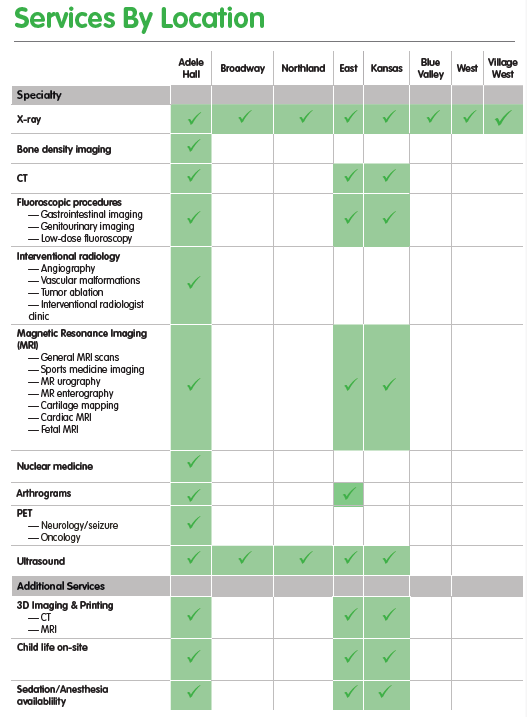Children’s Mercy Radiology – See The Difference
We love little bones. Which is why at Children’s Mercy, our Radiology team is focused on capturing the best image the first time — using the lowest amount of radiation necessary to get the highest quality image.
Many times, we receive suboptimal images from non-pediatric focused imaging locations that have caused the patient to endure more radiation than required. Oftentimes this leads to additional radiology tests and cost to the families, just to get a proper image for diagnosis. We want to make sure your patients don’t go through this duplicative process.
Below are examples of images we’ve received compared to images taken at a Children’s Mercy location. See the difference and review our Frequently Asked Questions — answered by our own pediatric board-certified radiologists.
Example one: frontal view of the pelvis
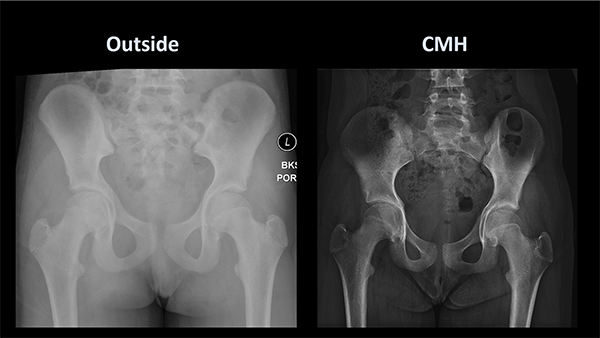
- Outside: Poorly exposed. Suboptimal bone detail.
- CMH: Exposure optimized to superior resolution of bone detail.
Example two: frontal view of the left wrist
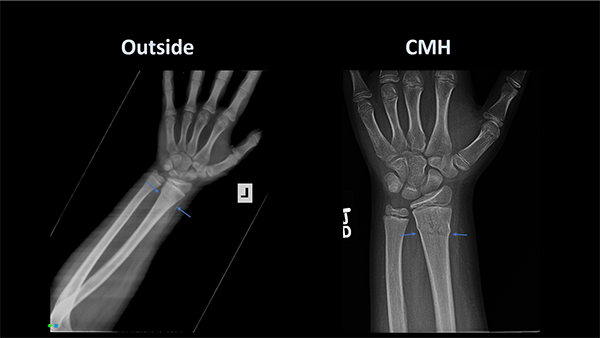
-
Outside: Blurred image. Exposure of the entire forearm to radiation rather than focused just to the wrist, area of interest.
-
CMH: Follow-up x-ray obtained in CMH fracture clinic is focused to the pertinent body part, eliminating unnecessary radiation exposure. Technique optimized to provide superior resolution of bone detail.
Example three: frontal view of the left knee
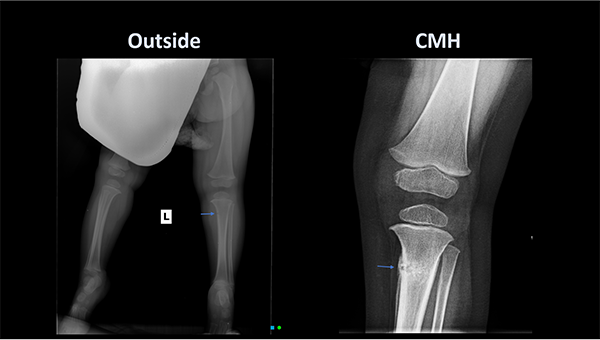
-
Outside: Suboptimal exposure resulting in blurring of the image, poor bone detail. Both lower extremities were unnecessarily exposed to radiation rather than focused on the left knee, area of interest.
-
CMH: Follow-up image obtained at CMH is focused to the pertinent body part, eliminating unnecessary radiation exposure. Technique optimized to provide superior resolution of bone detail.
Example four: frontal view of the right clavicle
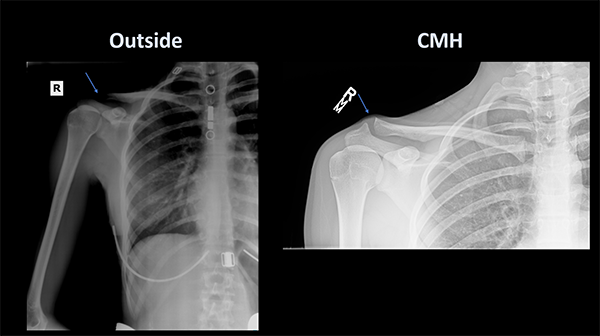
-
Patient with right acromioclavicular joint pain after injury
-
Outside: The image is overexposed to the point you cannot even see the right acromioclavicular joint. The right arm, entire right chest and upper abdomen were unnecessarily exposed to radiation.
-
CMH: Image focused only on the right clavicle, area of interest. Technique optimized to provide superior resolution of bone detail.
Example five: lateral elbow
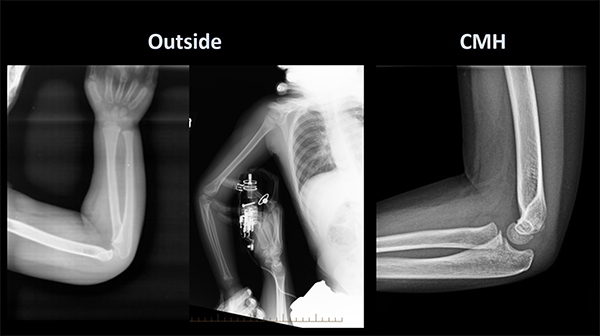
-
Outside: Two outside examples of poorly imaged elbows. Poor centering of the image on the area of interest. In one case the whole arm, and in the other the whole right side of the body, was unnecessarily exposed to radiation. In the second image, the technologist's hand and exposure control button are in the image, partially obscuring pertinent anatomy.
-
CMH: A properly positioned lateral elbow. Proper lateral positioning is essential in identifying an elbow joint effusion, often the only clue to an occult elbow fracture. Also the technique is optimized to provide superior resolution of bone detail.
Frequently asked questions
The most common “what’s the best test” inquiries we receive are in regards to brain imaging for headache, fluoroscopy exams for vomiting/dysphagia, soft tissue lumps and bumps, and developmental hip dysplasia.
-
In general, the best place to start with a screening exam for headache is a non-contrast head CT.
-
The best fluoroscopy test for vomiting/dysphagia is most often an Upper GI. Upper GI studies evaluate the esophagus, stomach and duodeneum. Upper GI studies evaluate for malrotation; a small bowel follow-through is not necessary to exclude malrotation. Small bowel follow-through exams are appropriate in younger children with concern for stricture/obstruction (ex: history of necrotizing enterocolitis, bowel resection). Small bowel follow-throughs are appropriate in older children when concerned about inflammatory bowel disease, stricture or obstruction.
-
The best initial test for soft tissue lumps and bumps is ultrasound. If the lump/bump is bony or hard, consider ordering US + X-ray.
-
Under the age of 6 months, ultrasound is recommended to screen for DDH; over the age of 6 months x-ray is best.
If there is ever a question, we have radiologists available 24 hours/day, 7 days/week. Never hesitate to call and ask! We can be reached by calling (816) 234-3270. Option 4.
We get asked this all the time!
-
Regarding brain imaging, screening head CTs are almost always done without contrast. Contrast is appropriate if there is concern for infection and in some cases of midline facial lumps and bumps.
-
When ordering CT abdomen/pelvis, we recommend IV contrast in all cases with the exception of renal stones – these are best seen on a non-contrast study. Oral contrast is also recommended in all cases with the exceptions of appendicitis and trauma.
-
MRI is a little less straightforward. It is most often safe to order without contrast. Our radiologists protocol and monitor each MRI as it is being performed. If we deem contrast necessary, we will give it.
Again, we are available 24/7 for questions. Please do not hesitate to contact us!
-
CT: Regarding CT, most kids can get through an exam without sedation/anesthesia. Our Child Life Specialists are hugely beneficial in making this happen.
-
MRI: We can attempt to swaddle any child up to the age of 3 months and/or weight of 6 kilograms.
This is always handled on a case-by-case basis. In appropriate situations we are open to trying as a “non-sedate” and converting to anesthesia if necessary.
We are available for consultation at any time.
Patients need to be kept NPO for the following exams:
-
Fluoroscopy: Esophagram, Upper GI, Upper GI with small bowel follow-through (2 hours NPO under 12 months; 4 hours NPO over 12 months)
-
Ultrasound: Ultrasound abdomen complete, Ultrasound right upper quadrant, Renal Doppler, Aorta/IVC (4-8 hrs depending on age), Pylorus (2 hours)
-
CT/MRI: Any CT or MRI with the potential need for sedation.
Results are available to referring clinicians on My Patient Connections within 1-2 hours of being signed off by the radiologist.
“Call report” requests can be made for urgent findings – fracture, pneumonia, etc. We always appreciate when you provide a back office number or cell phone number at which you can be easily reached.
Contact Us
For health care providers, please order diagnostic tests here.
To learn more, call: (816) 234-3270 | answered 24/7.
To schedule, call: (816) 234-3272.
Additional details about imaging at Children’s Mercy are available here.
